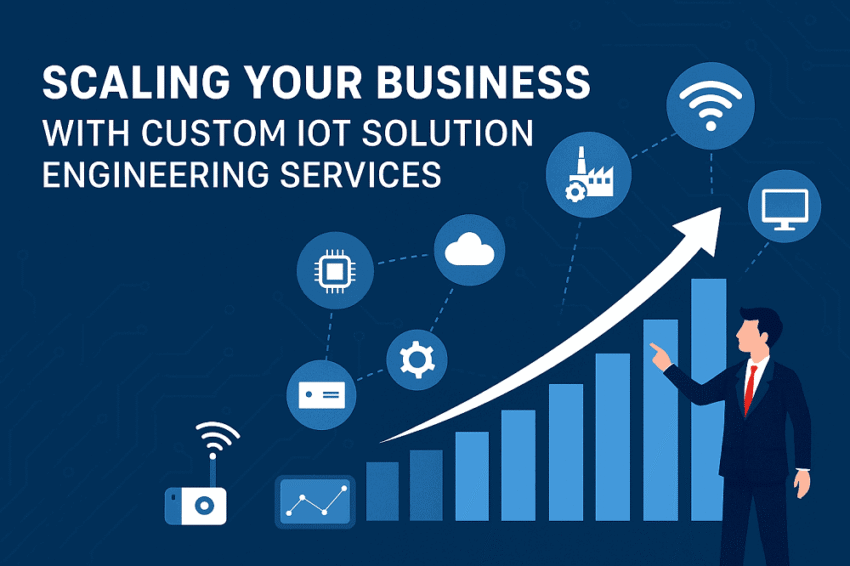Growth is the goal of every firm. Yet growth becomes hard when systems do not speak to each other. Data gets stuck in silos. Teams guess instead of knowing. Custom IoT Solution Engineering Services fix this gap. They turn raw device data into clear insight. They link machines, apps, and people. When built right, they unlock scale without chaos.
2. Why Scaling Needs IoT
Scaling is more than selling more units. It means handling higher demand with the same or lower cost. The Internet of Things (IoT) helps in two key ways:
-
Real-time data: Sensors report use, stress, and faults the moment they happen.
-
Remote control: Cloud commands adjust devices without site visits.
With these two powers, firms add sites, lines, or staff without losing control.
3. What Are Custom IoT Solution Engineering Services?
Most off-the-shelf IoT kits meet hobby needs. They fail in complex, high-risk settings. Custom IoT Solution Engineering Services give you a system that fits your use case, rules, and budget.
A skilled team studies your workflows, picks the best stack, and builds each layer:
-
Hardware design: Boards, sensors, and enclosures.
-
Firmware code: Low-power, secure, and easy to patch.
-
Network plan: Wi-Fi, LTE-M, LoRaWAN, or a mix.
-
Edge and cloud apps: Fast local logic and deep cloud insight.
-
User tools: Dashboards, alerts, and mobile control.
-
Support: Over-the-air updates (OTA) and 24/7 help.
The result is a single, safe, and future-proof platform.
4. Core Elements of a Custom IoT Solution
a. Device Strategy and Design
Pick sensors that give valuable data, not noise. Design PCBs for low heat and long life. Add secure boot to block hacks.
b. Secure Connectivity
All traffic must use TLS. Keys should live in a hardware root of trust. A zero-trust model keeps each device on a “need-to-talk” basis.
c. Cloud and Edge Integration
Edge nodes cut latency and save bandwidth. The cloud stores history and runs models that need heavy compute.
d. Data Analytics and Visualization
Build simple charts first: uptime, output, and fault rate. Then train ML models for demand forecast and predictive service.
e. Lifecycle Support
Plan OTA updates from day one. This keeps firmware safe and adds features without truck rolls.
5. Five Practical Steps to Scale with IoT
-
Define clear goals
List pain points. Rank them by value. “Cut downtime by 25%” beats “collect more data.” -
Start with a pilot
Choose one line or site. Limit scope. Prove gains fast. Use feedback to refine the design. -
Integrate data streams
Link IoT data to ERP, CRM, and BI tools. Let users see one source of truth. -
Automate key workflows
Use rules to trigger actions. Example: When a motor temp rises, slow speed and alert maintenance. -
Measure ROI and expand
Track KPIs quarterly. If the pilot hits targets, roll out to other sites. Reuse code and lessons to cut cost.
6. Industry Use Cases
| Sector | Quick Win with Custom IoT Solution Engineering Services |
|---|---|
| Manufacturing | Predictive machine service cuts unplanned stops by 30%. |
| Retail | Smart shelves track stock and prevent loss. |
| Healthcare | Cold-chain IoT keeps vaccines at safe temps. |
| Agriculture | Soil sensors and drone data boost yield with less water. |
| Smart Cities | Connected meters reduce power waste and spot leaks. |
7. Common Challenges and How to Beat Them
-
Security fears
Solve with end-to-end encryption and regular audits. -
Data overload
Use edge filtering to drop noise. Only store useful events. -
Legacy systems
Add gateways that translate old protocols to modern APIs. -
Change resistance
Train staff early. Show quick wins to build trust.
8. Choosing the Right Engineering Partner
A partner should offer more than code. Check for:
-
Full-stack skill: Hardware, firmware, DevOps, and data science.
-
Vertical know-how: Proven work in your field.
-
Agile process: Small sprints and clear demos.
-
Security focus: ISO 27001 or SOC 2 badges help.
-
Post-launch care: 24/7 NOC, SLA terms, and upgrade roadmap.
Ask for case studies. Call past clients. Good partners share both wins and lessons.
9. Future Trends to Watch
-
5G and private LTE: Lower latency expands edge AI use.
-
Matter and OPC UA FX: New standards that improve device talk.
-
TinyML: Models run on micro-watts at the sensor itself.
-
Digital twins: Real-time 3D copies of sites drive what-if tests.
-
Energy harvesting: Solar, RF, and thermal sources erase battery swaps.
Keeping an eye on these trends keeps your platform ahead.
Conclusion
Scaling is a journey, not a one-time task. Custom IoT Solution Engineering Services give a solid, tailored base for that journey. They turn scattered data into clear action, cut waste, and let you grow with less risk. Start small, learn fast, and expand with intent. The right IoT partner will guide each step, safeguard data, and unlock new value as you rise.

